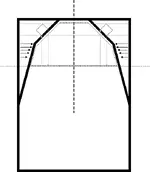Charoo, there isn't any easy way to calculate non-parallel walls - the problem is, even if you use an average, the non-parallel condition makes it so that those modal frequencies are NOT as accentuated as they would be if the walls were parallel. This is why some people, including Everest, make comments that it's possibly better to stay parallel and deal with "the devil you know" - Until recently, I agreed but the more I think about it, the more I'm inclined to use splayed walls to eliminate early reflections in the mix position.
As far as I know, the only way to REALLY know what's going on in a room is to BUILD it and MEASURE it. Of course, you do need to have an idea of what you want first, and this is where all the theory and planning come in.
In my next studio, I intend to use designs similar to the ones John Sayers does, concentrating first on outer shell sound PROOFING, then build the inner rooms to the size/shape/juxtaposition I want, but NOT concerning myself with non-internal wall treatment AT ALL, until I've had a chance to put up the music and LISTEN, as well as TEST.
Then, and ONLY then, will I spend any time and money making ANY of the surfaces a specific characteristic. One of the reasons this seems like a practical way to go (for me, anyway) is that I will be doing both 5.1 and 2.1 as well as stereo mixes, so some of the conventional wisdoms will no longer apply (mostly in 5.1 mixing)
I think the best you can hope for is to design a plane-syymetrical space, either splayed or parallel (your choice) based on your own study of the factors involved, and build it ALL like it was going to be a BOAT, and it couldn't leak.
As to wall construction, check out this thread on John's new site if you haven't already...
http://www.homer.com.au/phpBB2/viewtopic.php?t=86
I highly recommend checking out the US Gypsum information - there's an incredible amount of useful stuff there... Steve

